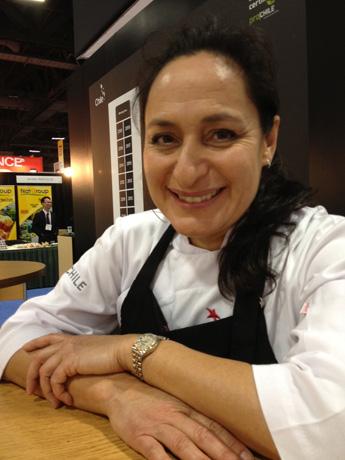Delicious Defined
By • November 6, 2012 0 2838

Delicious (di-?li-sh?s) adj. 1. Highly pleasing or agreeable to the senses, esp. of taste or smell. 2. Very pleasant; delightful.
How would you define delicious? Perhaps the most ubiquitous word in the English language to denote appreciation of the culinary spectrum, delicious signifies our love for everything from a single exquisite bite to the grand flavors of a cultural heritage. From lemongrass to lemon ice, if it makes our tongues jump, “Delicious!” seems to say it all.
But what is it? How do you place it? And in a city like Washington, with a newly erupted, sprawling and vibrant food culture awash in international influence, where is it?
My quest for delicious took me through the ringer of Washington’s food scene. The Fancy Food Show exposed me to the geography of the world’s gastronomic and agricultural landscape. The Rammy Awards, which honor the District’s area restaurant industry, helped me hunt down the places to sample delicious in my hometown. Finally, it was my conversations with local chefs—the torchbearers of all that is delicious—that opened my senses to the essence of unforgettable food. This is the story of how my culinary boat got rocked.
Delicious was on my mind the evening before the Summer Fancy Food Show kicked off at the Walter E. Washington Convention Center last week. The Fancy Food Show, put on by the National Association for the Specialty Food Trade, is a celebration of food from around the world. Each year, thousands of vendors gather to showcase their latest innovations in food, from cutting edge ingredients to new food products, which keep the world fed in continually creative—and sometimes astonishing—ways.
From June 17 through June 19, the main hall of the convention center was transformed into an epicurean Epcot Center. As D.C. restaurant patriarch José Andrés said, “In every corner, you’re gonna find a surprise.”
Walking among the stands, largely arranged by international and state regions, there were new food fancies you never knew about and old favorites you can’t believe you forgot. When is the last time you had a bite of perfectly cooked kielbasa, for instance? Or how about caramel corn? Or some good old-fashioned bread dipped in olive oil and salt?
Granted, at the Fancy Food Show, you won’t just be sampling some standard McCormick kosher salt. This year, you were tasting mineral-rich natural salt blends by Chef Salt, a Pennsylvania-based company that harvests salt from natural deposits and rare salt ponds around the world. The results are packed with gorgeous varieties of earthy, unique, yet wonderfully familiar flavors. What it could do to a piece of bread was wild. What it could do to a cut of tenderloin is unprecedented. It was… delicious.
If you’ve never been to the Fancy Food Show, be advised: the amount of good food is overwhelming. There is no way to describe it all. But Below are some personal highlights from the event. Fortunately, most of the foods discussed are available at specialty stores around the Washington area or will be soon. Keep your eyes and mouths peeled, or take a trip to your nearest search engine to find out where you can get a hold of these products.
With each taste, my curiosity deepened. Good as everything was, the foods were entirely unique to one another. There wasn’t any particular unifying thread. I was still left thinking, “What is delicious?”
Is it exemplified by the natural product of nature, like a slice of ripe summer peach? Is it a prepared and plated experience, liked fresh grilled squid on a bed of polenta? Is it the balance of flavor, the sweet, sour, spicy, salty and savory? Maybe it’s just the nature of flavor itself that we enjoy.
Does delicious account for location, season, tradition, mood, knowledge, price or preference? Well, yes—but it’s all relative. A watermelon might be delicious, but you won’t likely find a delicious watermelon in the middle of winter. Roasted butternut squash can be delicious, but in its raw state it is inedible to most people. Salt makes things delicious in the proper doses, but — as we all have likely experienced — over-salting will ruin a dish. Palates are also different and inconsistent—to some, licorice is delicious, while others wouldn’t touch it with a stick. If you are stressed or under the weather, your palate can be off—you might not even notice a perfect bite of food if you had it.
I could run in logistical circles until I lost my appetite, but at the heart of this screwy little dilemma there is something fundamental and significant: food keeps us alive, and to consider the nature of good food is to consider the essence of a good life. Because that’s what food is: life.
On June 24, the Rammy Awards announced to Washington the local restaurants they deemed most noble in their pursuit of delicious. Put on by the Restaurant Association of Metropolitan Washington (RAMW) each year for the last three decades, the Rammy Awards give out accolades to metropolitan Washington’s exemplary restaurants.
Understanding the full spectrum of food tradition, they have continually expanded their program to recognize achievements in numerous food service capacities. This year, the Rammys gave out 18 awards in categories ranging from Fine Dining Restaurant of the Year and New Restaurant of the Year, to Rising Culinary Star and Beverage/Mixology Program. See winners here.
It’s important to have an institution like RAMW to honor the culinary achievements of Washington’s restaurant scene. But still, I wanted to know more about the what and why of restaurants, the spark behind the flame of culinary obsession. More importantly, though, I was still after the essence of good food, the root of delicious.
I decided to go right to the source. I wanted to talk to chefs about the essence of delicious, to find out what it means to them, and how they employ those principles in their kitchens. With the help of chef and restaurateur Ris Lacoste, I began contacting a diverse selection of local chefs—people who know delicious. What I learned left me happy, satisfied and in wonder. Not unlike a delicious meal.
SPECTRUM OF DELICIOUS: FANCY FOOD SHOW FAVORITES
We already discussed our favorite salty offering at the Summer Fancy Food Show—and Chef Salt is definitely worth tracking down (hint: it’s available at Crate & Barrel)—but how about our other flavor receptors? Below is The Georgetowner’s breakdown of the best of the sensory experiences from this year’s Show: the savory, the sweet, and some less traditional but equally pleasurable taste categories. If you want, you can turn the list into a citywide foodie scavenger hunt.
Savory
Italy showcased a swath of oils, wines, chocolates and cheeses, as well as a mouthwatering Porchetta from Fa Lu Cioli, a near century-old company operating in Via delle Cerquette, about an hour south of Rome. Porchetta, a whole deboned pig (including the head), is a traditional early Roman preparation. Roasted for hours at nearly 1,000 degrees Fahrenheit, the final product is a perfectly roasted cut of meat with crackling orange skin and a soft, herbaceous center. Whether sliced alongside pickles and mustard as an appetizer, served as the main course with potatoes and vegetables, or layered into a sandwich, this stuff is great. You can buy pre-roasted cuts of Fa Lu Cioli’s Porchetta to heat up at home in the oven.
Sweet
In Townshend, Vermont, Big Picture Farm is making farmstead goat milk caramel, a wholly unique agricultural product that takes any caramel experience you’ve had to a new level of delicious. Somewhere between a caramel chew and a funky ripe cheese, these little morsels show us that even candy can have a distinct provenance; in each funky-sweet bite lingers the salt of the grazed Vermontian earth. Go find Big Picture Farm online www.bigpicturefarm.com, and order these things immediately. Even if you don’t, you’ll probably be seeing them around town soon—they took the gold medal for a confection product at the show, and they are going to be eaten up by local and national distributors.
Crunchy
Vendors from Spain brought over impressive collections of rustic wines, cured meats and sheep’s milk cheese. My favorite items, however, were fried and salted marcona almonds from Almondeli, a company on the southeast coastal town of Alicante that devotes itself entirely to this wonderfully distinct Spanish nut. I ate them as mindlessly and zealously as fresh salted popcorn.
Chocolaty
Massachusetts-based Taza Chocolate makes a granular, brilliantly textured stone ground chocolate in a process inspired by centuries-old Mexican chocolate traditions. The stones minimally refine the cacao beans, allowing tiny bits of cacao and cane sugar to remain in the finished chocolate, resulting in bright tastes and bold textures. Their Chipotle Chili chocolate is of particular note and recommendation. Among other places in the city, you can pick up a wheel-shaped hunk of Taza Chocolate with a cup of drip coffee at Peregrine Espresso in Eastern Market. Bring a book, and make a Sunday afternoon out of it.
Tipsy
Pallini distillery knows a thing or two about making world-class drinks—as you might expect from the oldest distillery in Rome. Their Limoncello has a natural earthy zest from the fragrant peel of Sfusato lemons hand-picked on the Amalfi coast, hitting your palette with an intense burst of smooth and tangy flavors. Word on the street is it’s a good addition to lemon chicken, or drizzled over sorbets and lemon cakes.
Innovative
Innovated in the 1970s in France and introduced to the U.S. in 1987, sous-vide (French for ”under vacuum”) is an innovative cooking technique developed by Bruno Goussault, where food is vacuum-sealed in a specially designed pouch, slow-cooked in water at low temperatures until perfectly and evenly cooked through, and then chilled until ready for use. The result is really pretty remarkable—cut open a roast beef and it is perfectly pink from the edge to the center. Just roast the outside, and it’s ready to eat. The process also seals in moisture, making food flavorful, tender and incredibly juicy.
Marketed by Cuisine Solutions in Alexandria, Virginia, cryovacking is a deceivingly simple, basic process that yields perfect results: start with great ingredients, and prepare them simply to enhance their natural flavors. As Cuisine Solutions’ chef Herve Chignon let out, the technique is employed by top chefs and restaurants around the city, from Michele Richard of Citronelle, to Fabbio Trabbocchi of Fiola and Cathal Armstrong of Restaurant Eve.
Culinary Cross-Culture
Perhaps my favorite stop of at the Fancy Food Show was Chile. The sprawling South American country is insulated by natural barriers on all sides: the Andes mountain range to the east, the Pacific Ocean on the western coast and the Antarctic near its southern tip. “In many ways we are closed off from the world,” says Pilar Rodrigues, Chilean cook and culinary diplomat, “but it has made for a very strong culture.”
Rodriguez works to expose the international community to the rich culinary traditions of her native country. After taking a degree at the Culinary Academy in Paris, the former Tommy Hilfiger marketing director for Latin America decided to drop out of the fashion industry and devote herself to her two driving passions: wine and food. “Most of my time, I spend promoting Chilean food and wine abroad,” she says. “Our wines and food are on par with any international cuisine, it’s just a matter of getting it out there.”
The humitas she served me, a tamale-like cornhusk filled with fresh shredded corn, basil and sofrito, was about perfect. For visitors to Chile, she also recommends pastel de choclo, a traditional corn and meat stew “that carries all the flavor of our rich land.”
“It’s the time for Latin America,” she says. “Everybody in the world is starting to come over. All our different flavors—from the equator to Antarctica—are starting to be noticed. I’m just giving things a little push.”
Look up Rodriguez online, and find out more—there’s a lot to know, and it’s all worth it.
DELICIOUS, AS DEFINED BY SOME FAVORITE LOCAL CHEFS
Speaking with a handful of acclaimed chefs from around the city, I asked a simple question: “What does ‘delicious’ mean to you?”
This is how they responded.
Bryan Voltaggio
Chef/owner of Volt and Family Meal
“Delicious” comes from a lot of places, I guess. It comes from the process behind creating a dish. That’s the exciting part—discovering new flavors or new ideas or new combinations on your own. But you have to be sure to understand: you don’t just cook for yourself, you cook for your guests. It’s also really exciting to get feedback. As chefs, handing our food to a guest for approval is what we strive for everyday.
Cooking is so much more than just one person behind a grill. We put it out there on a plate for our guests to experience. First, my team and I have to like it, and then we’ve got to hope our guests feel the same way as we do. It’s the communal nature of cooking that’s so cool.
That’s why I named my new restaurant Family Meal, because that’s what it signifies: getting together with the family to share a meal. We thought about this as a diner with that concept of getting families together at the table to appreciate breakfast, lunch and dinner. We’ll be open for every meal.
At my restaurants, there are some thought-provoking dishes, and others are very simply done, with few ingredients and the idea that it’s supposed to be pristine. The best ingredients, the best technique.
One dish at Volt that speaks toward all this is our goat cheese ravioli. We source the cheese from Cherry Glen Farm in Montgomery County. If I ever took it off the menu, I think it would start a riot. It’s on the menu with different garnishes throughout the year to stay true to the seasons, but it’s always there. When someone’s asked what’s your favorite dish at Volt, they always say the ravioli. It’s a comforting dish—it takes you back to your childhood in a lot of ways.
At Family Meal, I think that dish is going to be our fried chicken. I’m serious [laughs]. You’ll just have to try it.
Kaz Okochi
Chef/co-owner of Kaz Sushi Bistro
As an eater, “delicious” is a personal thing. It is something I put in my mouth that makes me smile. It’s not that often, but a few times a year. And when I feel it, the food is usually in its simplest form. Like a perfect strawberry, which doesn’t happen very often—maybe once a year if I’m lucky. Or a peach or tomato, or simply grilled fish with no sauces.
However, as a chef I unfortunately cannot just give people food in the simplest way. As a chef, the approach is a little bit different—more complicated and uprising. But the ingredients have to be good. Then, we have to create something with them. And in that sense, delicious is also all about balance. Flavor, texture, the proper combining of ingredients. Sometimes, I taste something unbalanced and my palette gets confused—that is not good. I don’t want my customers to be confused.
Plus, delicious is a completely personal question. I can say, “That’s my favorite dish!” But that doesn’t mean it’s your favorite dish or your girlfriend’s. It would be easy to say, “Tuna is my favorite fish.” And that satisfies the question. Kaz loves tuna. But I may like snapper tomorrow or yellowtail the day after. It changes every day because an ingredient is not the same every day. So, my philosophy is why pick a favorite with so many good options?
I’m not good at picking my favorite thing anyway, because it changes all the time. And it should change with the seasons. I only love tomatoes when they’re good and ripe in the summer. If you ask me the same question in the wintertime, I don’t like tomatoes.
Customers ask everyday for my favorite thing at the restaurant. So, maybe I just tell them I love salmon, and that’s the end of the conversation. But I’m lying.
Jeffrey Buben
Chef/owner of Vidalia and Bistro Bis
To me, a lot of food is based on taste memory. So, when you get into the idea of delicious, it’s got to appeal to all your senses. Something delicious draws from your memory and imagination. It could be as simple as an apple. You know what an apple tastes like. But when you go to market and bite into that one apple with the right amount of sugar, ripeness and texture, you just go, “Wow, that’s delicious.” It brings together all your memories and ideas of what an apple is and it’s the best possible version of it. That is the culmination of all your senses, what your mind tells you it’s supposed to be like. The most satisfying sensation is when you hit that note.
That sense of memory is why I’ve stuck to the French European culinary tradition for most of my career. You can invent combos and put things together that shock the senses and put you in a place where all your preconceived notions are blown to hell, and that’s all good. But how often is that described as delicious?
But if you make a stew, or you braise something, and you do it perfectly, the whole world will come flooding into your mouth. That’s why you cook, and that’s why you eat. That feeling transcends all my other ideas around food. Boeuf bourguignon and a glass of red wine usually does it for me. It just takes over all of my senses [laughs].
Tracy O’Grady
Chef/co-owner of Willow Restaurant
I think that “delicious” food is part of what’s got us into the weight issue in this country [laughs]. Especially us chefs, all of us trying to make the most delicious burger, fries, whatever it is. And most of that deliciousness is added through fat and salt. Some people might define delicious as farm-fresh vegetables or farmer’s market produce. Others will define it as an amazing prime steak.
But I think it’s definitely the quality of the ingredient and how you handle it—chefs are always trying to add layers of flavors. But there’s a gray area between the ingredient and the cooking: I’ve seen people take really good product and ruin it. And I’ve seen people take not-so-great product to a new level.
But good, fresh ingredients are a must. As far as the idea of farm-to-table, it’s funny where we’ve come in our culture. At Willow, I don’t state where all my vegetables come from on my menu—it’s a given that if you come eat here, you get fresh herbs, fresh produce and the best cuts of meat. Of course, it’s fresh—getting choice produce is just part of my job.
When you come in, try our grilled flatbreads—we literally grill flatbread pizza on a grill. We do cheese blends and use great quality ingredients, of course. It’s just a vehicle for flavor and texture. It’s so simple, but you put any flavor profile on top, and it’s good. I have a lot of fun with that.
Roberto Donna
Executive chef of La Forchetta Ristorante
Delicious is any kind of food that you put in your mouth that makes you open your eyes and say, “Wow, that tastes good.” It’s something that gives you an immense sensation of happiness and joy. Delicious is equal to joy.
My mother had a grocery store when I was growing up in Turin [Italy], and my grandparents were vegetable gardeners. When they had something in their hands that was good to taste—a fresh vegetable or even a piece of bread—they would give it to me to bring me joy. When you taste something good, it makes you feel good. It’s all love: food is love. You eat with love, you drink with love, you grow and raise food with love. If you do it for different reasons, it never comes out good.
You know, if you cook while you’re in a good mood, the food comes out good. If you cook in a bad mood, the food is usually not so good. The food knows this. At my restaurant, we have a lasagnetta, which I think is a good example of my feelings on this. It’s a lasagne casserole that brings me back in my memories. It’s a Sunday dish we made with our family when we got together. It was the love my family had for each other—and now I share that with my dinner guests.
Mike Isabella
Chef/owner of Graffiato, chef/partner of Bandolero
Delicious is what naturally tastes good. Half of my job in serving good food is to buy good products. Maybe that just sounds lazy [laughs].
But that is my concept as a chef. But what do I like? I really just like simple, good food, and I try to bring that out in my menus. Graffiato has its roots in a sort of salt-of-the-earth, seasonal Italian tradition—very much inspired by an “old country” mentality, like my grandmother used to cook. We try to make big flavor happen without overdoing it—just bring out the ingredients as naturally and beautifully as we can.
At Bandolero, I’m after that same thing. Mexican cuisine is so good because the ingredients are just right there in your face—pumpkin seeds, avocado, tomato, habanero—and they’re some of the best ingredients in the world. It’s hard to go wrong. Still, I think we definitely do it right.
Cathal Armstrong
Chef/owner of Restaurant Eve
Without getting too esoteric about it, what I always try to teach people when creating delicious food is balancing acidity with sweetness, and then an understanding of texture contrast.
When you think about the finest wines of the world, they always have a good balanced structure between ripe fruit and good, bracing acidity on the palette. And they also have depth and texture contrast, where it stays in your mouth with a long and lingering sense. I think food should be made the same way.
If everything is sweet, then it’s too cloying. Too sour, and it’s puckering. No texture, and it’s flat and boring.
Sweetness doesn’t mean sugar exclusively—the sweet taste of pork is a natural sweetness, carrots, parsnips, beef, fresh seafood. They all have a natural, earthy sweetness to them. And when balanced with a little acidity it creates beautiful contrast. And that will give you that lingering flavor that makes you want more of it all of the time.
There’s one dish that’s been on the menu of Restaurant Eve since we opened, called OOO. It stands for onions, oysters and Ossetra caviar. It’s a rich creamy dish: you get the natural sweetness of the onion, and then the brininess of the oyster and caviar to balance it. And to create texture contrast we serve it in a crisp puff pastry. The sweetness of onion, brininess of the oyster and caviar and the crunchiness of the pastry. To me, that is a complete dish.
Bob Kinkead
Chef/owner of Kinkead’s and Sibling Rivalry
Delicious is when food is in balance. As basic as it sounds, food that is correctly seasoned achieves a balance of tastes—like tart versus sweet—that creates unprecedented flavor. Something precisely cooked, in keeping with seasonal ingredients at the peak of ripeness—this, to me, is where the essential, natural flavor of the food shines through.
Another component that enhances our experience is that epiphany of eating something sublime for the first time. Nothing beats those moments where you realize what great food really is.
Ris Lacoste
Executive chef/owner of RIS
There is no better word a chef wants to hear from a guest than “delicious.” There is no better word for me to experience. It’s one of those “super words” that invokes a passion and satisfaction, something that goes beyond a single element in a dish—it means you have reached their heart and soul, you have made their whole being content. When you taste something like that, you lack and want for nothing.
Delicious comes in many forms, from a single pure essence to a finely tuned symphony of flavors and textures. It might even just be a memory, like a favorite meal at your mother’s table, something delicious perhaps only to you.
As a chef, delicious comes from heart and soul, from a life force created by memories and passion, all transferred from you to the guest through the food you cook.
- Jordan Wright
- Yelp
- Sackler Gallery
- Chef Pilar, at the Fancy Food Show, on a mission to spread the word on Chilean food

















